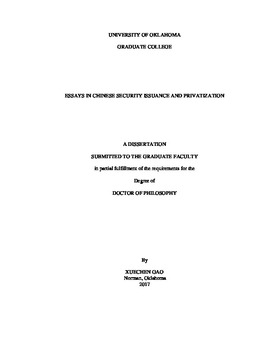| dc.description.abstract | This dissertation is a collection of three essays which study the impacts of different types of government ownership on a firm’s post-privatization performance, the underlying cause for the change in Chinese share-issue privatization listing strategies, and the equity flotation method selection mechanism of Chinese listed companies.
In Chapter 1, I compare central government ownership with local government ownership in a privatization framework and investigate whether and how the two types of government ownership affect a firm’s post-privatization performance differently. With 757 partial privatizations through private placements in China over the period of 2006 to 2015, I find that firms owned by the central government experience greater increases in real net profits, while firms owned by local governments have slightly better profitability improvements after private placement privatizations. However, firms owned by the two types of government experience similar post-privatization changes in capital investments, operating efficiency, and leverage. In addition, the market shows roughly the same level of positive reactions to privatization plan announcements of firms with either central government or local government ownership. My findings indicate that central and local government ownerships only have limited differences in their impacts on firm profitability and net profits. Overall, they have similar net effects on firm operations and performance although they have different advantages and disadvantages.
During the early years of China’s share-issue privatization program, most large state-owned enterprises (SOEs) were initially listed on overseas stock markets. This pattern changed dramatically after 2007, when Chinese domestic stock markets became significantly more attractive to SOEs and most SIPs went public on the Shanghai or Shenzhen stock exchanges. In Chapter 2, we posit two explanations for this change in listing strategy. First, increasing Chinese stock market absorptive capacity might have given SOEs more incentive to list domestically because their financing needs could then be better satisfied in markets with higher absorptive capacity. Alternatively, the shift could result from the Chinese government’s enactment of new laws, regulations, and policies around 2007 encouraged (or forced) Chinese SOEs to list in Shanghai. Using a sample of 1,494 Chinese SIPs that raised $566 billion between 1990 and 2014, we find empirical support for both predictions.
Chapter 3 compares three major equity flotation methods frequently employed by listed firms in Chinese markets. Rights offering was the dominant flotation method prior to 2005. However, there was an apparent preference shift from rights offerings to private placements after 2005. We check the valuation effects of the three methods before and after 2005 and use a multinomial logit test to identify the determinants in the flotation method selection mechanism. Our results support the information asymmetry hypothesis by showing that firms with high level of information asymmetry tend to choose private placements and avoid public offerings. Ownership structure doesn’t seem to be an important factor determining the selection of flotation methods. Profitability requirements for refinancing prevent a lot of listed firms from raising additional external capital. The removal of profitability requirements for private placements in 2006 boosts the popularity of private placements and explains the shift from rights offerings to private placements to some extent. | en_US |
